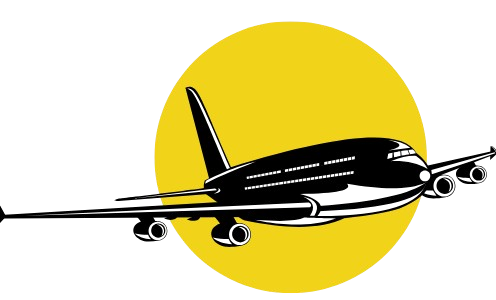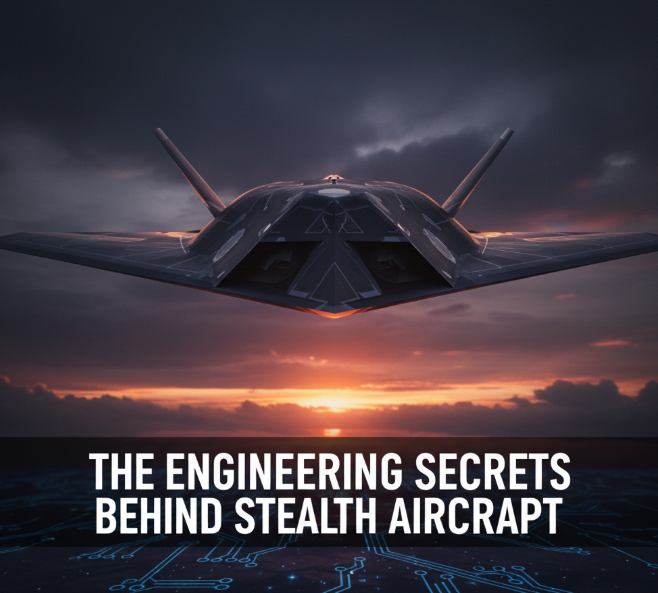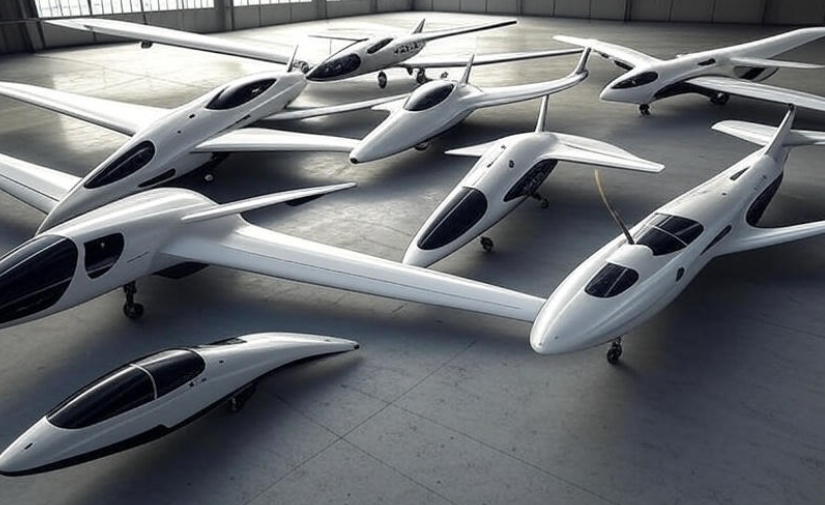Picture a fighter pilot whizzing through hostile territory in an invisible plane, undetectable by radar. That’s not science fiction — that’s the game-changing technology that made modern warfare possible. The stealth aircraft are among the most advanced engineering feats in human history, bringing physics and materials science together to extraordinary effect in designs that can themselves be hidden.
These organic motorcars are (allegedly) billion-dollar wonders, which can fly right on through detection systems that would normally pick up a plain regular plane at nearly 400 miles. But how exactly do they work? What makes them so special? We’ll get a guided tour of the fascinating science behind stealth aircraft in this article, from their unusual shapes to their special coatings and beyond.
What Makes an Aircraft “Stealthy”?
While we get into the technical details, let’s clarify what exactly “stealth” is in aviation. A stealth plane isn’t invisible — you can still look up and see it with your own eyes if you’re close enough. Rather, stealth technology is geared toward making the planes difficult — ideally impossible — to track with radar, infrared sensors and other electronic detectors that militaries use to follow aircraft.
Think of it as donning camouflage in a forest. You’re not really invisible, but you blend in so well that it’s very difficult for someone to see you. Stealth machinery operates on the same principle, after all—the only difference being that it’s “hiding” from electronic eyes rather than human ones.
The ultimate objective of stealth technology is lowering what engineers call the “radar cross-section” or RCS. This is essentially a yardstick for how easily radar waves can bounce off an aircraft and reach the radar receiver. The smaller the aircraft’s radar cross-section, the more difficult it is to detect.
The Shape Game: Angular Designs That Play With Radar
One of the most overt aspects of stealth aircraft is the bold, oddball angles. Unlike traditional jets with their sleek, rounded surfaces, stealth planes look as if they’re built from flat panels and sharp edges. And, there’s a very good reason for this bizarre design.
How Radar Waves Bounce
If those radar waves encounter a curved surface, they can rebound in various directions, including directly back toward the radar station that sent them out. It makes the plane easy to spot. But when radar waves meet flat or angled surfaces, they return in certain directions — ideally not toward the radar station.
Stealth aircrafts’ flat surfaces are angled in a particular orientation to reflect radar waves away from the source. It’s like standing in a room full of mirrors tilted at an angle: The light gets bounced around in unpredictable patterns instead of directly back to you.
Famous Stealth Shapes
The F-117 Nighthawk, the first operational stealth fighter in the world, took this idea to an extreme. It earned the nickname “Wobbly Goblin” for its faceted appearance, which made it look as though someone had unfolded a piece of paper and turned it into an airplane. Every surface was either flat or angled just right to bounce radar waves away.
Newer stealth planes, like the F-22 and F-35, are based on angular designs that are smoother and more polished than their early predecessors. These days, engineers have computer models to calculate precisely how radar waves will bounce off complex shapes of the sort that they make into modern warplanes, and so with a few flicks of software, you can wonder from a safe distance at what could well be an aerodynamically savvy aircraft — even if it’s designed for stealth.
Special Materials and Radar-Absorbing Coatings
An aircraft isn’t truly stealthy based on shape alone. Engineers also employ special materials and coatings that can absorb radar waves, rather than bouncing them back. They are known as radar-absorbent materials, or RAM for short.
Composite Materials
Today, stealthy aircraft are constructed out of composites—a collection of materials that use the strengths of one material to counteract another. These composites may contain carbon fiber, or fiberglass, as well as special resins that can absorb radio waves.
Conventional aircraft are constructed largely of metals like aluminum and steel, which are good reflecting radar signals. That is the opposite of what you want in a stealth plane! Composites are able to help engineers create strong, lightweight structures that aid in stealth.
The Secret Paint Job
The black paint and coatings applied to the surfaces of stealth aircraft are, perhaps, one of the most confidentially kept secrets regarding these types of planes. And they’re not your ordinary spray paints — these formulations feature iron ball particles embedded in a polymer base or carbon-based materials for absorbing electromagnetic radiation.
The covert recipe for these coatings is classified, but we know that they operate by converting radar energy into heat, rather than reflecting it back. The warmth is simply released into the air.
These aren’t fragile coatings which are costly to upkeep. To maintain stealth, those aircraft need special climate-controlled hangars and their coatings must be regularly inspected and touched up. Even a tiny scratch or chip in the coating can form a “hot spot” for radar to pick up.
Concealing the Sizzle: Design of the Engine and Exhaust
Jet engines are one of the largest challenges in designing a stealth aircraft. They’re hot, they emit exhaust gases, there are spinning fan blades — which can all be ascertained by various sensors.
Concealing the Engine Intakes
The big spinning fan at the front of a jet engine is, for all intents and purposes, a perfect radar reflector. It’s round, it’s metallic, and it points in one direction — all the wrong features on a stealth aircraft.
Special inlet designs are used in stealth aircraft to conceal the engine face. Some employ serpentine or S-shaped air ducts that bend before they reach the engine, shielding the fan blades directly from radar waves. Others feature special screens or grills that block the radar while permitting air to pass through.
Cooling the Exhaust
The heat given off by jet engines can be picked up by heat-seeking missiles and infrared sensors. To lower this infrared signature, stealth aircraft sometimes employ some rather neat tricks:
Exhaust Mixing: The hot exhaust gases are mixed with cooler outside air at the earliest point available to drop the temperature. Some designs rely on winglets to produce minuscule vortices that quickly mix warm and cool air.
Flat Nozzles: Instead of round exhaust nozzles, most stealth planes use flat, rectangular ones. These form a thin, broad plume of exhaust that cools more quickly than a circular one.
Shielding: The exhaust is frequently oriented so that the plane’s body shields it from view from below or certain viewing angles, making it more difficult for ground-based sensors to pick up.
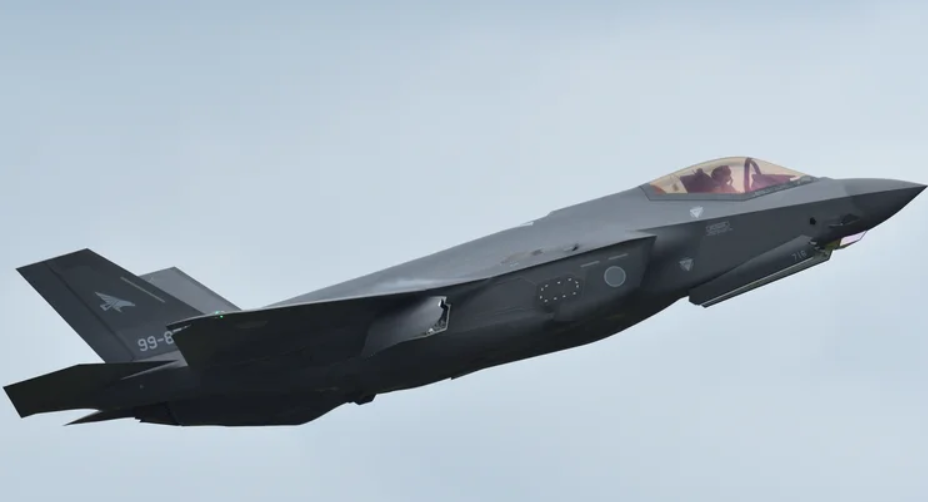
Managing Edges and Gaps
Every edge, every panel line, every door and every opening on an aircraft can reflect radar waves. Traditional planes have hundreds of these; stealthed aircraft go to extreme lengths to reduce them.
Edge Alignment
Take a good look from above at an aircraft like the stealthy F-22 or F-35, he told me: you will see something curious — that many of the edges are parallel to one another, even if they’re in different parts of the plane. For instance, the front edges of the wings could be parallel to the edges of the tail.
The slides essentially align the edges or planforms of the stacked layers in a process known as “edge alignment” or “planform alignment,” so that radar waves will be strongly reflected at only a few specific angles, rather than numerous different angles. Think instead about the challenge of designing a mission so as to circumvent those few problematic angles rather than radar detection at every conceivable angle.
Seamless Panels
Typical planes have visible panel lines, rivets and fasteners all over the airframe. Each of these generates a small radar return. Stealth airplanes incorporate special design features to achieve a highly smooth surface with few gaps and ducts and very few fasteners.
Panels snap together with astonishingly small tolerances, often only a fraction of a millimeter. Any remaining gaps are sealed with special tapes and sealants. Even the weapons are enclosed internally in special bays to minimize reflections on the outside.
The Electronic Struggle: Radar Warning and EW
Stealth is not only the ability to be unseen, but also the ability to know when you are seen and have ways to confuse enemy systems.
Radar Warning Receivers
Stealth aircraft carry advanced radar warning receivers that tell the aircrews when they are being illuminated by radar waves. Using these systems, they can detect what sort of radar is being used, how strong the signal is and from which direction it is coming.
That information helps pilots respond — such as by turning to present a better stealth angle, or deploying electronic countermeasures.
Active Cancellation
Active radar cancellation systems are some of the latest stealth technologies. They function as noise-canceling headphones, but for radar waves. When the plane senses that radar is coming its way, it sends out a signal which is meant to be a kind of “negative reflection,” canceling out the reflection just as noise-canceling headphones do, so the image becomes that of an airplane seeming to disappear.
This is an evolutionary, not revolutionary, technology, but it is near the cutting edge of stealth research.
The Trade-offs of Going Stealth
Stealth technology, however, is a marvel with major downsides that shape the ways in which these vehicles can be employed.
| Advantage | Disadvantage |
|---|---|
| Stealthy appearance Hard to detect on radars | Expensive (cost for developing and maintaining) |
| Can cross defended air space | Sensitive surface coatings reduce operational capability |
| Tactical surprise | Limited by internal weapons storage |
| Lower pilot danger | Low observable features can result in less maneuverability |
| High mission success rate | Requires special hangars and facilities |
The Cost Factor
Stealth aircraft are extraordinarily expensive. An F-35 runs about $80 million, while an F-22 Raptor came out at about $150 million per plane. A big chunk of this cost is due to the specialized materials, exacting manufacturing needs and aggressive testing required.
Maintenance Challenges
A stealth aircraft needs a lot of work to make it stay that way. The protective coatings wear off over time and have to be reapplied. Every panel must be an exact fit, so repairs are complicated and time-consuming. These performance planes require climate-controlled hangars to shield their sensitive equipment.
A stealth aircraft may require 30 to 50 hours of maintenance for every hour it spends in the air, versus 10 or 20 hours for a conventional fighter.
Performance Compromises
There can be down sides to sneaky design features. The angular forms that deflect radar aren’t always the most aerodynamic. Internal Weapons bays dictate the number of weapons an aircraft can carry. The special coatings add weight.
While tunnellers always want to be as stealthy as possible, the need for speed, manoeuvrability, range and payload must also be thought through.
Real-World Stealth Aircraft Examples
Here are a few stealth aircraft we have, and what makes each one unique.
F-117 Nighthawk (Retired)
The F-117 was the world’s first operational stealth aircraft, in service from 1983. Its radical faceted nature rendered it one of the most stealthy of craft and also one of the most difficult to fly. The computers needed to continually make midair adjustments to keep it steady. It was retired in 2008 but established that stealth technology actually worked against enemies.
B-2 Spirit Bomber
The B-2 is a tailless flying wing design that has a distinctive bat-like appearance and is capable of performing extremely long missions at high altitudes. Its rounded lines are precisely designed to reduce radar cross-section. Each B-2 was priced at more than $2 billion, making it one of the most expensive military planes ever produced. Only 21 were constructed.
F-22 Raptor
The F-22 is a mix of stealth and extreme performance. It can fly faster than the speed of sound without afterburners (so-called “supercruise”), and it is highly maneuverable. The F-22 is a more evolved stealth technology trade-off among the many things that are traded.
F-35 Lightning II
The F-35 is the most common stealth fighter; separate versions are used by the Air Force, Navy and Marines. Key to the unmanned maneuver vehicle’s mission is versatility and information collection, as advanced sensors are used to gather battlefield data and share it with other friendly forces.
The Future of Stealth Technology
Stealth technology has been advancing and new applications are on the way.
Next-Generation Materials
Scientists are designing metamaterials—man-made substances with properties that do not appear in nature. These had the potential to make aircraft even stealthier or stealth to new kinds of sensors.
Adaptive Camouflage
Researchers are also making surfaces that can dynamically alter their characteristics to respond in real time to various threats. Think of an airplane skin that could adapt its radar-reflecting properties depending on what type of radar was being deployed against it.
Sixth-Generation Fighters
The next fighters have already started to take shape. Those people-killers will almost certainly have even stealthier characteristics — perhaps with the capability to maneuver drones from a distance — and may be autonomous in nature.
Counter-Stealth Technology
Of course, the success of stealth has caused counter-stealth to evolve. The resulting impact on safety, efficiency and the cost of operations can be devastating if not addressed properly. To assist in stopping stealth technology from becoming obsolete to new radar systems operating at other frequencies, networked sensor systems and numerical computing, it will become difficult for the stealth aircraft remain undetected. It leads to a never-ending tech arms race.
How Stealth Changed Modern Warfare
The concept of stealth is taking military strategy and tactics to a new realm.
Prior to stealth, targets defended by surface-to-air missiles and anti-aircraft guns could be reached only at great cost or with a large force of aircraft. Stealth aircraft can slip through air defenses that would obliterate regular planes, enabling militaries to attack key targets with little warning.
That means this ability alters the mathematics of conflict. It is a means by which even heavily defended targets can be struck, influencing how countries array their forces and defend against those of others.
Stealth has also affected the conduct of nation states. Countries with stealth aircraft have capabilities that others do not, giving themselves an asymmetric edge. That pushes other countries to create their own stealth programs or work on counter-stealth technologies.
Frequently Asked Questions
Can stealth aircraft be detected by radar at all?
Yes — but only at far shorter ranges than conventional aircraft. An aircraft that would normally be detected at 100 miles may only become detectable at about 20 miles using stealth technology. Some have shown that certain variants of radar, based on different frequencies, are able to detect stealth aircraft better than others but possibly with less precision when it comes to tracking them.
Are stealth aircraft completely invisible?
No, they’re simply very difficult to see with radar and other sensors. You can see them with your naked eye, and in some circumstances, specialized radar systems are even able to pick them up. Stealth doesn’t make you undetectable but instead reduces the range of detection.
Why do all military planes not have stealth?
Stealth is wicked expensive and also involves operational restrictions. For a lot of missions, the rewards aren’t worth it. Stealth is most useful for aircraft that have to plunge into heavily defended airspace. For all other roles, conventional airplanes are both more practical and cheaper to operate.
How long is stealth in an aircraft?
The stealth coverings also age and need constant maintenance. An aircraft could require coating touch-ups every few flights. The structural stealth features -shape, materials- have the lifetime of the aircrafts but coatings need care.
Can stealth aircraft be seen or heard?
Yes, if you’re close enough. There is no such thing as a really “Stealth” vehicle, but the design tries to minimise electronic not visual or acoustic signatures and some quite effort to keep it silent. But by the time you can see or hear a stealth plane, it’s probably too late to mount an effective defense.
Which countries have stealth aircraft?
Today, the United States has the largest and most sophisticated stealth air armada in world history. China and Russia have their own stealth aircraft programs. Several other nations are seeking to develop or researching stealth and its applications.
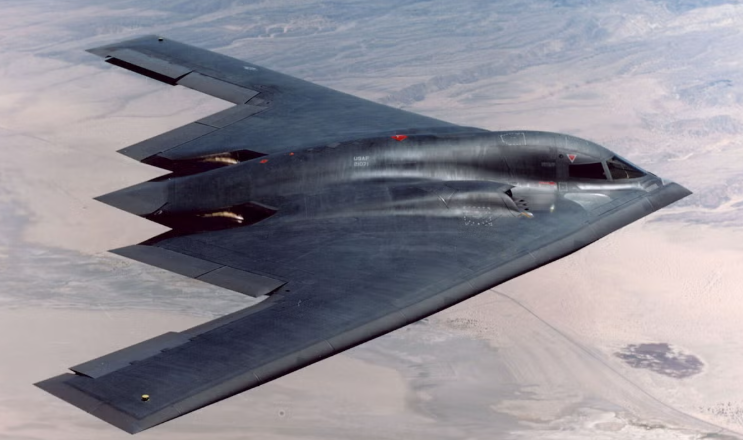
Final Thoughts
However, stealth planes are one of mankind’s most incredible and sexy technological feats. They blend cutting-edge physics with materials science, aerodynamics and electrical engineering to make devices that can penetrate barriers, elude defenders and incapacitate targets — tools that in the future could help avert pandemics or defeat terrorist plots.
The engineering tricks that make stealth possible — an array of jagged angles to deflect radar waves, materials and coatings that absorb any leftover radiation, the modulation of heat output and deceptions to confuse enemy sensors — all these add up to machines that have changed modern warfare.
But stealth comes at a price. They are expensive to make and operate, and they lose some of the other performance. As sensors get better and a stealth arms race rages on, engineers keep finding new ways of overcoming the limitations imposed by radar.
Whether you think these planes are an engineering marvel or a cause to be concerned about global security, there’s no question they have commanded attention. The secrets of stealth aircraft remind us what’s possible when we dare to leap the technology curve and they tease even greater possibilities that just may be lurking right around the corner.
Thinking ahead, stealth is likely to both spread and become more sophisticated, as a technology and also by getting written about. But the fundamentals — shape, materials and handling signatures — will still be at the core of such aeronautics as they continue to produce aircraft that disappear in plain sight.
